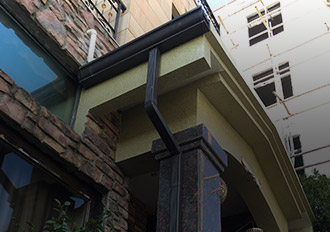THE LATEST IN ROOFING
Sometimes you want an adhesive that’s modestly sticky and easily reversed—like a sticky note. Other times, it needs to be darn near irreversible. High-performance building contractors also need to consider adhesive tapes capable of withstanding temperature extremes and volatile moisture conditions; adhere to a wide variety of substrates; and tolerate the dust and dirt found on the surfaces of the building materials or the job site. Is that acrylic or butyl? Silicon or rubber? Here’s what you need to know.
What Are the Types of Adhesives Used in Tape?
That said, there are four basic types of adhesives used in tape all of which differ in characteristics as well as cost.
Rubber: Adhesives that are based on natural or synthetic rubbers and formulated with tackifying resins, oils, and anti-oxidants. Rubber is often the most cost-effective adhesive and offers quick stick capability. Rubber adhesive is not recommended for high heat applications. It also does not perform well in colder temperatures, especially if it reaches below the freezing point of 32°Fahrenheit.
Butyl: A specialized rubber adhesive system, butyl was developed to augment traditional rubber adhesives because they are less temperature-sensitive and maintain their tackiness at much lower temperatures than natural rubber. And while butyl sticks better to more substrates, butyl is also more expensive.
Acrylic: Acrylic adhesives can be water-based, solvent-based, or “solid.” Water-based adhesives are the least expensive of the three and generally do not bond to as wide a variety of substrates as solvent-based ones. Solid acrylic adhesives can form the strongest adhesive bonds at a wide range of temperatures and even achieve adhesion to damp or wet substrates. Solid acrylic adhesives are also VOC-free, and the absence of any solvents means little to no embrittlement of the tapes over time. Both water- and solvent-based acrylics are similar in cost to butyl rubber tapes; however acrylic adhesives typically develop a stronger bond than the traditional Rubber adhesive and are able to take higher temperatures
Silicone: Formulated with Silicone polymers and the only adhesive that will bond well with silicone substrates. Silicone adhesives are relatively expensive and have a very low initial tack, but can withstand higher temperatures than both Rubber and Acrylic adhesive
So, which is the best fit for your application? Well, for builders and professional contractors, it really comes down to butyl and acrylic. So let’s take a closer look at these two popular adhesive technologies.
What Is Butyl Tape, Exactly?
Butyl tape is an example of a synthetic rubber adhesive. It’s a solvent-based adhesive that is formulated in the lab instead of coming from a rubber tree. All types of rubber adhesive are thermoplastic, so exposure to high heat will soften the adhesive and impact its effectiveness. However, butyl adhesives are formulated to be less sensitive to temperature variations. They stay more flexible in cold weather and more stable in high temperatures than natural rubber adhesives. Because butyl tapes are extremely durable, with have good flex properties, they are often used in applications where an airtight bond is required. In fact, most butyl tapes also come with a liner since the adhesive system is aggressive and forms a permanent bond to the surface it sticks to – even if that surface is itself!
When Are The Advantages of Butyl Tapes?
Advantages:
High initial tack—has a more aggressive hold on contact than acrylic adhesives
Has a high level of adhesion because it bonds to a huge variety of surfaces
Less expensive than acrylic adhesive
Impermeable to air
Waterproof so it works well in situations where water is a factor
Disadvantages:
Even though butyl adhesives are less sensitive to temperature variations they still cannot match the range or performance of acrylic adhesives.
Does not hold up over time to direct exposure to UV light or chemicals
Susceptible to oxidation and may darken or discolor
Ideal for:
Seaming and flashing windows and doors
Repairing leaks
What Is Acrylic Tape, Exactly?
Acrylic tapes are either water- or solvent-based. They are created by crosslinking monomers to create polymers with specific properties. Acrylic adhesives are naturally tacky so they don’t require as many additives during the manufacturing process as rubber adhesives. Offering a good balance of adhesion, shear and tack, tapes with acrylic adhesive systems are resistant to thermal and UV degradation. They can be used on many surfaces and perform in a much wider application temperature range – typically anywhere from -30°F to 300°F. The only real downside is the cost; these tapes cost a bit more than the rubber or asphaltic tapes. Builders often use acrylic tapes to completely seal a home, creating an airtight envelope.
When Are The Advantages to Acrylic Tapes?
Advantages:
Offers superior durability and longevity on polar surfaces (i.e. metal, glass, and polycarbonates)
Will not break down when exposed to extreme temperatures, UV light, chemicals or oxidation
Color stable and resistant to aging (will remain clear and not yellow)
Have a high level of cohesion (ability to stick to itself)
Are considered “greener” or more environmentally friendly in that do not off-gas or pollute landfills
Disadvantages:
Needs time (usually 24-72 hours) to fully set
Poor adhesion to low energy or non-polar surfaces
Impermeable to air only on polar surfaces
More expensive than butyl adhesives
Ideal for:
Seaming vapor barriers, house wraps, and rigid foam insulation
As always, the adhesive compound is just one factor that should be taken into account when selecting the right tape for the right application. Characteristics like backing, strength, and permeability, as well as environmental conditions and substrate, are a few other factors that can impact the job, and ultimately, its success.
Still not sure which type is right for your application? Contact us.



REQUEST A QUOTE
Copyright © Hangzhou Singer Building Materials Co., Ltd. All Rights Reserved |
Sitemap
| Powered by 
SEOKeywords:Roof Tile ManufacturerRoof Shingle ManufacturerAsphalt Shingle SupplierRain Gutter CompanyShingle Roofing CompanyWaterproof Tape For RoofPressed Steel Roofing TilesRain Gutter SystemGray Asphalt ShingleStone Coated Metal Roofing Manufacturer